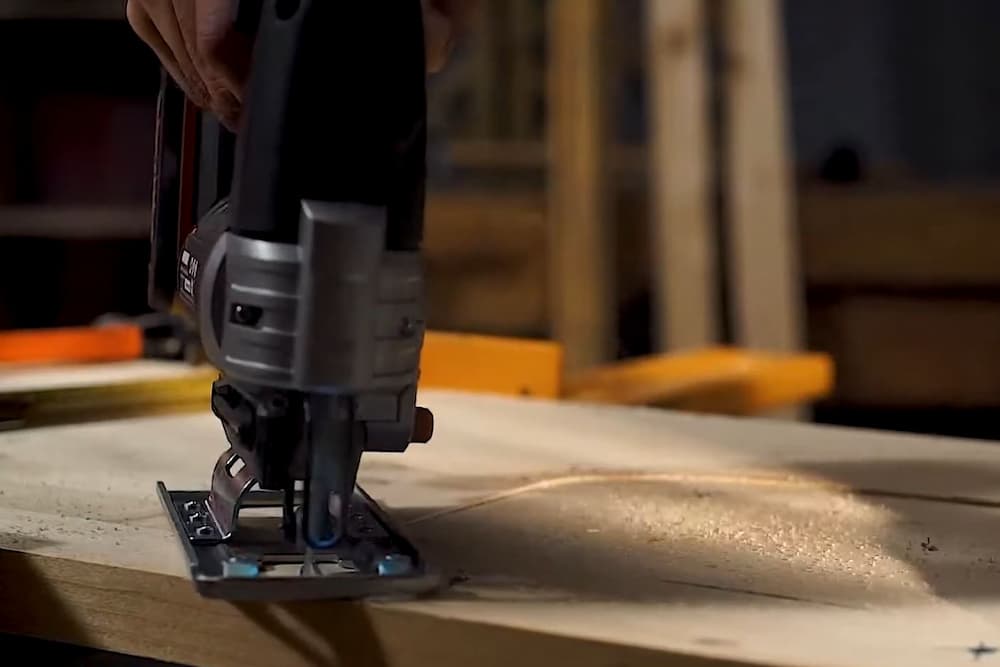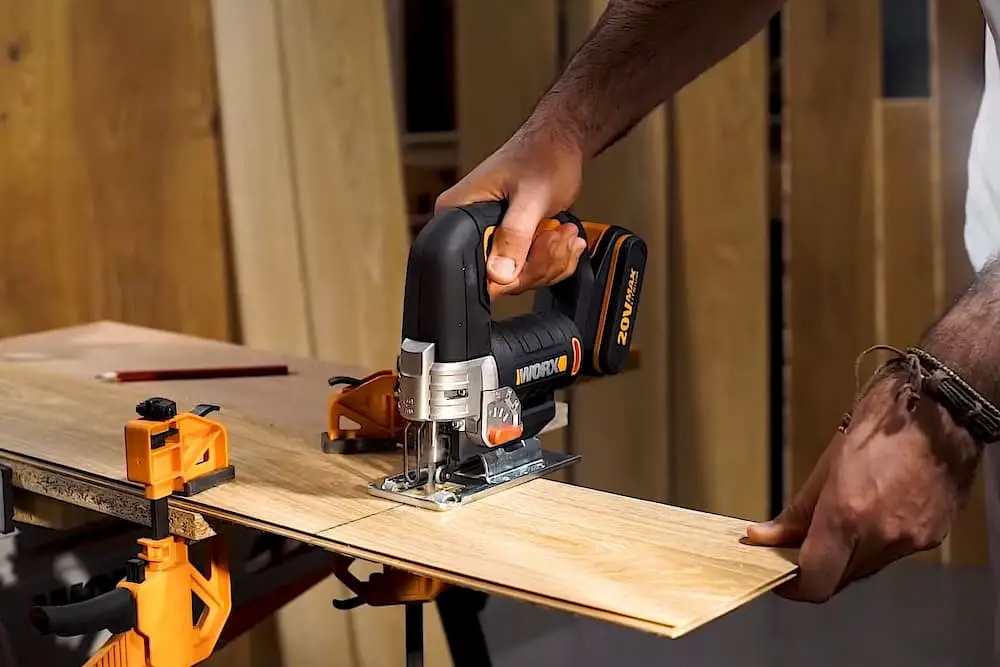Hello, fellow DIYers and woodworking aficionados!
In this post, we’ll explore the art of cutting plywood with a jigsaw, a must-have tool for any DIY enthusiast.
Plywood, being a highly adaptable and widely-used material, often plays a crucial role in a multitude of woodworking projects, from cabinetry to furniture building. Having the ability to make clean, accurate cuts in plywood with your trusty jigsaw can elevate your woodworking game to new heights.
So, without further ado, let’s delve into the ins and outs of mastering this essential technique!
Can I cut plywood with a jigsaw?
You bet! A jigsaw is a highly adaptable power tool that excels at cutting plywood. Equipped with the appropriate blade and employing the correct methods, you’ll find that a jigsaw is not only capable of making straight cuts but also shines in creating curved and angled cuts in plywood. Its flexibility and precision make it an ideal choice for tackling various plywood cutting tasks, helping you achieve remarkable results in your woodworking projects.
How to choose the right jigsaw and blade for plywood?
Picking the perfect jigsaw and blade for cutting plywood is a vital step in ensuring success. Though I’ve delved into the details of corded and cordless jigsaws and their features in a previous article, it’s essential to highlight the importance of selecting a jigsaw with variable speed control and an orbital action setting for this task.
When it comes to jigsaw blades, your choice can significantly impact the quality and cleanliness of your cut. For cutting plywood, it’s best to go for a blade that has fine teeth and is specifically designed for wood or laminate materials. Don’t underestimate the value of a sharp blade either! A well-honed blade not only minimizes the risk of splintering but also contributes to a smoother and more efficient cutting experience.
How to cut plywood with a jigsaw?
Preparing the plywood for cutting
Begin by measuring and marking the plywood to achieve the desired cut. Employ a straight edge and a pencil to produce distinct, precise lines. To keep the plywood stable and prevent any movement during cutting, fasten it securely to a sturdy work surface using clamps or a vise. To minimize tear-out and splintering, you might want to apply masking tape along the cut line or score it gently with a utility knife.
Setting Up the Jigsaw
Optimize your jigsaw’s settings for the most effective cutting experience. Adjust the speed control to maintain a moderate pace, and deactivate the orbital action to achieve a neater cut. Carefully install the blade, double-checking that it’s locked in position and aligned with the saw’s base.
Cutting the Plywood
Once you’re all set, proceed to cut along the marked lines with accuracy, maintaining consistent pace and pressure throughout. Keep the jigsaw’s base flush against the plywood at all times. Adapt your technique depending on whether you’re making straight, curved, or angled cuts. For curved cuts, take your time and use relief cuts when necessary.
Finishing the Cut
As you near the end of the cut, exercise caution and precision to avoid any splintering. After completing the cut, use fine-grit sandpaper to sand and smooth the edges, removing any lingering rough spots for a polished final result.

How to Cut Plywood with a Jigsaw without Splintering and Chipping?
Why Plywood Splinters?
Plywood is susceptible to splintering due to its composition of multiple thin layers of wood veneer bonded together with glue. This layered structure makes it vulnerable to chipping and splintering when cut. Moreover, improper cutting techniques, using the wrong type of blade, or working with a dull blade can aggravate the problem, leading to unattractive and uneven edges on your plywood piece.
Ways to Avoid Splintering and Chipping
To accomplish a smooth, splinter-free cut, implement the following methods:
- Utilize a Zero Clearance Insert: By supporting the plywood directly next to the cutting edge, this insert reduces tear-out and splintering.
- Select the Appropriate Blade: Choose a fine-toothed blade specifically designed for laminates or even opt for a metal-cutting blade to help achieve a cleaner cut.
- Maintain a Sharp Blade: A keen blade cuts more effectively and results in less splintering compared to a dull one.
- Cut at a Moderate Pace: Keep a steady, controlled pace while cutting to minimize the chances of chipping and splintering.
- Use Masking Tape: Apply one or two layers of masking tape on both sides of the cut line to hold the wood fibers together and help prevent tear-out.
- Score the Cut Line: Employ a utility knife to gently score the cut line before proceeding with the actual cut, which aids in reducing splintering.
- Deactivate the Orbital action: If your jigsaw features a orbital action function, turn it off to lessen the blade’s aggressive motion and decrease the likelihood of splintering.
Common Plywood Cutting Mistakes
- Using the Wrong Type of Blade: Selecting an inappropriate blade for cutting plywood can result in poor cut quality, splintering, or increased difficulty when cutting.
- Cutting with a Dull Blade: A dull blade not only makes the cutting process harder but also increases the risk of splintering, chipping, and tear-out.
- Not Securing the Plywood Properly: Failing to firmly attach the plywood to a stable work surface can cause it to shift during cutting, potentially leading to inaccurate cuts and an increased risk of accidents.
- Rushing Through the Cut: Cutting at a high speed or with excessive force can compromise the quality of the cut and increase the likelihood of splintering or chipping.
- Failing to Support the Plywood Adequately During the Cut: Insufficient support for the plywood, especially near the cut line, can result in tear-out, uneven cuts, or even damage to the material.
- Neglecting to Wear Proper Safety Equipment: Cutting plywood with a jigsaw involves certain risks, so it’s essential to wear appropriate safety gear, such as goggles, gloves, and hearing protection, to minimize the chances of injury.

What are Jigsaw Alternatives for Cutting Plywood?
- Circular Saw: This power tool is perfect for making straight cuts in plywood with impressive accuracy. With the proper guide, a circular saw can produce clean, precise cuts for various woodworking projects.
- Table Saw: A table saw like Bosch 4100-10 provides exceptional precision when cutting and has the capacity to rip large sheets of plywood with ease. This stationary tool is ideal for those with a dedicated woodworking space and can handle a wide range of cuts and angles.
- Hand Saw: For smaller projects or situations where power tools may not be accessible, a hand saw offers a straightforward, manual option. Although it requires more effort and may not be as precise as power tools, a hand saw can still achieve decent results in cutting plywood.
- Router: A router is a versatile tool that excels at cutting intricate shapes and profiles into plywood. With the right bit and a steady hand, a router can create clean, decorative cuts for more complex woodworking designs.
Frequently Asked Questions
Is there any difference between cutting 3/4 plywood vs 1/4 plywood with a jigsaw?
Indeed, there is a difference. Cutting thicker plywood, such as 3/4-inch plywood, requires a more potent jigsaw and a blade with larger, more aggressive teeth to ensure a smooth and accurate cut. On the other hand, when working with thinner plywood, like 1/4-inch plywood, a less powerful jigsaw paired with a blade featuring finer teeth will suffice, leading to a cleaner and more precise cut. Additionally, when cutting thicker plywood, you may need to adjust the cutting speed and technique to avoid splintering and ensure a smooth edge.
Conclusion
And there you have it, folks! We’ve covered the essential tips and techniques for cutting plywood with a jigsaw, as well as ways to prevent splintering and chipping.
Remember, the key to success lies in choosing the right jigsaw and blade, securing the plywood properly, and maintaining a steady pace while cutting.
To recap, here are some specific tips and suggestions for your next plywood cutting project:
- Choose the right jigsaw and blade for the task, considering the thickness of the plywood and the type of cut you need to make.
- Ensure that your blade is sharp and install it correctly to minimize splintering and chipping.
- Secure the plywood to a stable work surface and support it adequately during the cut.
- Cut at a moderate pace, adjusting your speed based on the plywood’s thickness and the complexity of the cut.
- Take measures to prevent splintering, such as using masking tape or scoring the cut line before making the cut.
By following these tips, you’ll be well on your way to mastering the art of cutting plywood with a jigsaw. So, don’t be afraid to roll up your sleeves and give it a try. With some practice and patience, you’ll be making clean, precise cuts in no time. Good luck, and happy woodworking!

